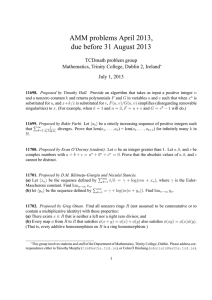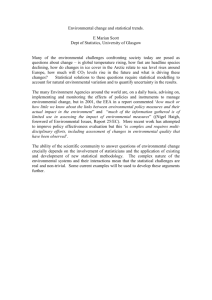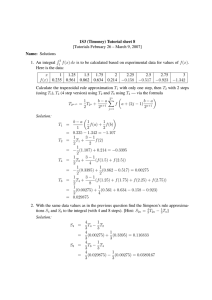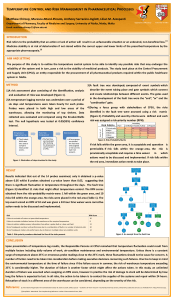Solution Set # 3
advertisement
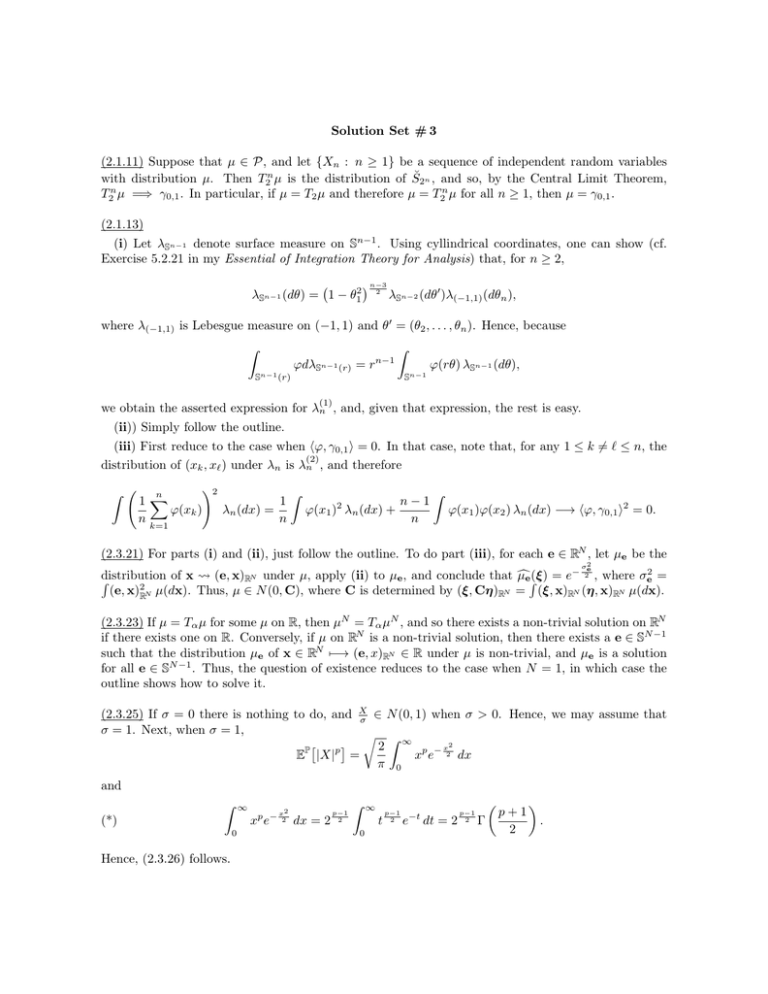
Solution Set # 3
(2.1.11) Suppose that µ ∈ P, and let {Xn : n ≥ 1} be a sequence of independent random variables
with distribution µ. Then T2n µ is the distribution of S̆2n , and so, by the Central Limit Theorem,
T2n µ =⇒ γ0,1 . In particular, if µ = T2 µ and therefore µ = T2n µ for all n ≥ 1, then µ = γ0,1 .
(2.1.13)
(i) Let λSn−1 denote surface measure on Sn−1 . Using cyllindrical coordinates, one can show (cf.
Exercise 5.2.21 in my Essential of Integration Theory for Analysis) that, for n ≥ 2,
λSn−1 (dθ) = 1 − θ12
n−3
2
λSn−2 (dθ0 )λ(−1,1) (dθn ),
where λ(−1,1) is Lebesgue measure on (−1, 1) and θ0 = (θ2 , . . . , θn ). Hence, because
Z
Sn−1 (r)
ϕdλSn−1 (r) = r
n−1
Z
Sn−1
ϕ(rθ) λSn−1 (dθ),
(1)
we obtain the asserted expression for λn , and, given that expression, the rest is easy.
(ii)) Simply follow the outline.
(iii) First reduce to the case when hϕ, γ0,1 i = 0. In that case, note that, for any 1 ≤ k 6= ` ≤ n, the
(2)
distribution of (xk , x` ) under λn is λn , and therefore
Z
n
1X
ϕ(xk )
n
k=1
!2
1
λn (dx) =
n
Z
n−1
ϕ(x1 ) λn (dx) +
n
2
Z
ϕ(x1 )ϕ(x2 ) λn (dx) −→ hϕ, γ0,1 i2 = 0.
(2.3.21) For parts (i) and (ii), just follow the outline. To do part (iii), for each e ∈ RN , let µe be the
2
σe
distribution
of x
(e, x)RN under µ, apply (ii) to µe , and conclude that µ
ceR(ξ) = e− 2 , where σe2 =
R
2
(e, x)RN µ(dx). Thus, µ ∈ N (0, C), where C is determined by (ξ, Cη)RN = (ξ, x)RN (η, x)RN µ(dx).
(2.3.23) If µ = Tα µ for some µ on R, then µN = Tα µN , and so there exists a non-trivial solution on RN
if there exists one on R. Conversely, if µ on RN is a non-trivial solution, then there exists a e ∈ SN −1
such that the distribution µe of x ∈ RN 7−→ (e, x)RN ∈ R under µ is non-trivial, and µe is a solution
for all e ∈ SN −1 . Thus, the question of existence reduces to the case when N = 1, in which case the
outline shows how to solve it.
(2.3.25) If σ = 0 there is nothing to do, and X
σ ∈ N (0, 1) when σ > 0. Hence, we may assume that
σ = 1. Next, when σ = 1,
r Z ∞
p
x2
2
P
xp e− 2 dx
E |X| =
π 0
and
Z
(*)
2
p − x2
x e
0
Hence, (2.3.26) follows.
∞
dx = 2
p−1
2
Z
∞
t
0
p−1
2
e
−t
dt = 2
p−1
2
Γ
p+1
2
.
(i) First note that
X
β
is 1-sub-Gaussian, and so it is enough to handle the case when β = 1. In this
case, the first estimate in Lemma 2.3.18 says that P(X ≥ R) ≤ 2e−
P
p
E |X|
Z
∞
t
=p
p−1
P |X| > t dt ≤ 2p
Z
∞
R2
2
, and so, by (*),
t2
p
tp−1 e− 2 dt = p2 2 Γ
p
0
0
2
.
σ
(ii) Again, by considering X
β , one can reduce to the case when β = 1 after replacing σ by β . Thus,
assume that β = 1. By Hölder’s inequality, EP [|X|p ] ≥ σ p for p ≥ 2. Now assume that p < 2. If
q ∈ (1, ∞), then 2 = pq + q10 2q−p
q−1 . Thus, by Hölder’s inequality,
1 1 2q−p p
2q−p 1
σ 2 = EP |X| q |X| q0 q−1 ≤ EP |X|p q EP |X| q−1 q0 .
Now choose q =
4−p
2 .
Then
2q−p
q−1
= 4, and the result follows by simple arithmetic.
(iii) Because S is B-sub-Gaussian and has variance Σ2 , there is nothing to do.
(iv) Follow the outline.
(2.2.28) and (2.3.29) Follow the outline.

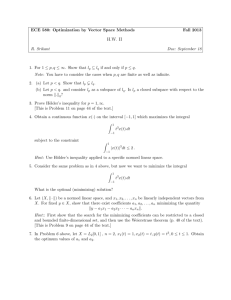
![MA3421 (Functional Analysis 1) Tutorial sheet 7 [November 20, 2014] Name: Solutions](http://s2.studylib.net/store/data/010731565_1-51ad01714c75b95d2b5f7e0d5655f78c-300x300.png)
